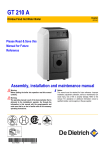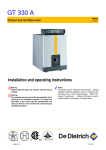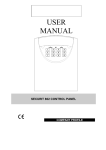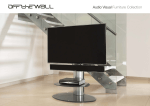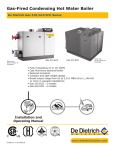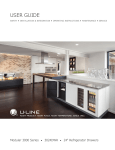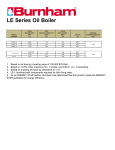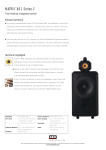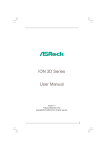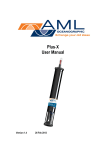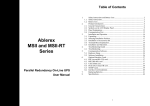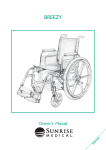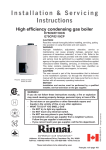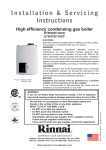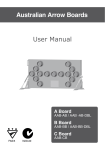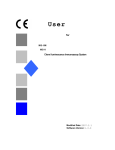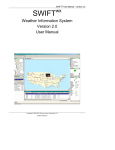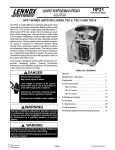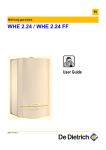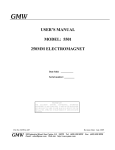Download GT 210 A - DeDietrich Boilers
Transcript
GT 210 A English Oil-Gas Fired Hot Water Boiler 11/03/09 Installation & Operating Manual Please Read & Save this Manual for Future Reference Warning: Before putting the boiler into operation read this manual carefully. Warning: The operating manual is part of the documentation that is delivered to the installation’s operator. Go through the information in this manual with the owner/operator and make sure that he or she is familiar with all the necessary operating instructions. 8227-4096-F 8227-4096-F Notice: This manual must be retained for future reference. Improper installation, adjustment, alteration, service or maintenance can cause injury, loss of life or property damage. Refer to this manual. For assistance or additional information consult a qualified installer, service agency or the fuel supplier. Guideline of Notices Safety Considerations Warning: indicates presence of hazards that can cause, if not avoided, severe personal injury, death or substantial property damage. ! Caution: indicates presence of hazards that will or can cause, if not avoided, minor personal injury or property damage. Notice: Application comment for optimum use of equipment and adjustment as well as useful information. Z Reference to an other instruction book. Please observe the following safety instructions. Read this manual carefully. Correct installation and adjustment of the burner and the control panel is a precondition for safe, efficient operation of the boiler. Read this manual and the specifications on the safety label carefully before attempting to put the burner into operation. not store or use gasoline or other flammable liquids in Do the vicinity of this or any other appliance. WHAT TO DO IF YOU SMELL GAS: - Do not try to light any appliance. - Do not touch any electric switch, do not use any phone in your building. - Immediately call your gas supplier from a neighbor’s phone. Follow the gas supplier’s instructions. - If you cannot reach your gas supplier, call the Fire Department. Observe the following symbols DANGER due to explosion of gas. - Work only on gas components when you have a license to do so. - Note that the assembly of gas and vent connections, the initial start-up, the electrical connections, the maintenance and service can only be performed by a licensed service contractor or technician. DANGER due to electricity. Installation and service must be performed by a qualified installer, service agency or the gas supplier. Warning: Improper installation, adjustment, and/or operation could cause carbon monoxide poisoning resulting in injury or death. This product must be installed and serviced by a professional service technician who is experienced and qualified in hot water boiler installation and gas combustion. - Prior to doing any work on the heating system, disconnect all electrical power to the boiler at the emergency switch. - It is NOT sufficient to shut off only the boiler control! ! CAUTION! SYSTEM DAMAGE due to improper installation. - Observe local and state codes as well as common industry practices during the installation and operation of the heating appliance. ! ! Caution: Strict compliance with these instructions is a precondition for the correct operation of the boiler. ! IMPORTANT Service on this boiler should be undertaken only by trained and skilled personnel. Keep boiler area clear and free from combustible materials, gasoline and other flammable vapors and liquids. Do not place any obstruction in the boiler room that will hinder the flow of combustion and ventilating air. Read these instructions carefully before proceeding with the installation of boiler. Post instructions near boiler for reference by owner and serviceman. Maintain instructions in legible condition. CAUTION! SYSTEM DAMAGE due to inadequate cleaning and maintenance. - A boiler cleaning and maintenance should be performed annually. Verify complete system operation at the same time. - Correct the problem immediately to prevent damage to the system! ! Caution: Refer to User’s Manual regarding the carcinogenic hazard of crystalline silica that may be found during installation, servicing and removal of this boiler. "Installation of this equipment must be in accordance to all local and national codes or authorities having jurisdiction” [Canadian Installations] • • [USA Installations] CSA B149 for gas fired boilers CSA B139 for oil fired boilers • • NFPA 54/ANSI Z223.1 for gas fired boiler NFPA 31 for oil fired boilers. ATTENTION-WARNING: The boiler must be connected to a venting system that will safely discharge all flue gas to the outside in a safe and effective manner. 2 Do not use gasoline, crankcase draining, or any other oil containing gasoline. GT 210 A The boiler is certified to burn fuels as listed on the boiler rating plate. Never burn garbage or paper in the unit, and never leave combustible materials in the vicinity of the boiler. 08/0121/08/06 - 94863106 - 82274096E Contents Regulations and guidelines . . . . . . . . . . . . . . . . . . . . . . . . . . . . . . . . . . . . . . . . . . . . . . . . . . . . . . . . . . . . . . . . . . . .4 General . . . . . . . . . . . . . . . . . . . . . . . . . . . . . . . . . . . . . . . . . . . . . . . . . . . . . . . . . . . . . . . . . . . . . . . . . . . . . . . . . . . . .4 1 Uncrating . . . . . . . . . . . . . . . . . . . . . . . . . . . . . . . . . . . . . . . . . . . . . . . . . . . . . . . . . . . . . . . . . . . . . . . . . . . . . . . . . . . . . . . . . . . . . . . .4 2 Technical specifications of boilers . . . . . . . . . . . . . . . . . . . . . . . . . . . . . . . . . . . . . . . . . . . . . . . . . . . . . . . . . . . . . . . . . . . . . . . . . . . . .5 3 Main Dimensions . . . . . . . . . . . . . . . . . . . . . . . . . . . . . . . . . . . . . . . . . . . . . . . . . . . . . . . . . . . . . . . . . . . . . . . . . . . . . . . . . . . . . . . . . .6 Installation . . . . . . . . . . . . . . . . . . . . . . . . . . . . . . . . . . . . . . . . . . . . . . . . . . . . . . . . . . . . . . . . . . . . . . . . . . . . . . . . . .7 1 2 3 4 Location . . . . . . . . . . . . . . . . . . . . . . . . . . . . . . . . . . . . . . . . . . . . . . . . . . . . . . . . . . . . . . . . . . . . . . . . . . . . . . . . . . . . . . . . . . . . . . . . .7 Aeration . . . . . . . . . . . . . . . . . . . . . . . . . . . . . . . . . . . . . . . . . . . . . . . . . . . . . . . . . . . . . . . . . . . . . . . . . . . . . . . . . . . . . . . . . . . . . . . . .8 Levelling . . . . . . . . . . . . . . . . . . . . . . . . . . . . . . . . . . . . . . . . . . . . . . . . . . . . . . . . . . . . . . . . . . . . . . . . . . . . . . . . . . . . . . . . . . . . . . . . .8 Water connection . . . . . . . . . . . . . . . . . . . . . . . . . . . . . . . . . . . . . . . . . . . . . . . . . . . . . . . . . . . . . . . . . . . . . . . . . . . . . . . . . . . . . . . . . .8 Assembly . . . . . . . . . . . . . . . . . . . . . . . . . . . . . . . . . . . . . . . . . . . . . . . . . . . . . . . . . . . . . . . . . . . . . . . . . . . . . . . . . . .9 Chimney connection . . . . . . . . . . . . . . . . . . . . . . . . . . . . . . . . . . . . . . . . . . . . . . . . . . . . . . . . . . . . . . . . . . . . . . . . .24 1 Flue size . . . . . . . . . . . . . . . . . . . . . . . . . . . . . . . . . . . . . . . . . . . . . . . . . . . . . . . . . . . . . . . . . . . . . . . . . . . . . . . . . . . . . . . . . . . . . . . .24 2 Connecting to the flue . . . . . . . . . . . . . . . . . . . . . . . . . . . . . . . . . . . . . . . . . . . . . . . . . . . . . . . . . . . . . . . . . . . . . . . . . . . . . . . . . . . . .24 Connecting the burner . . . . . . . . . . . . . . . . . . . . . . . . . . . . . . . . . . . . . . . . . . . . . . . . . . . . . . . . . . . . . . . . . . . . . . .24 Electrical connections. . . . . . . . . . . . . . . . . . . . . . . . . . . . . . . . . . . . . . . . . . . . . . . . . . . . . . . . . . . . . . . . . . . . . . . .25 Maintenance . . . . . . . . . . . . . . . . . . . . . . . . . . . . . . . . . . . . . . . . . . . . . . . . . . . . . . . . . . . . . . . . . . . . . . . . . . . . . . . .25 1 2 3 4 5 Boiler . . . . . . . . . . . . . . . . . . . . . . . . . . . . . . . . . . . . . . . . . . . . . . . . . . . . . . . . . . . . . . . . . . . . . . . . . . . . . . . . . . . . . . . . . . . . . . . . . .25 Domestic hot water (GT 2100) . . . . . . . . . . . . . . . . . . . . . . . . . . . . . . . . . . . . . . . . . . . . . . . . . . . . . . . . . . . . . . . . . . . . . . . . . . . . . . .26 Precautions required in the case of long boiler stops (one or more years) . . . . . . . . . . . . . . . . . . . . . . . . . . . . . . . . . . . . . . . . . . . . .26 Precautions required if the heating is stopped when there is a risk of freezing . . . . . . . . . . . . . . . . . . . . . . . . . . . . . . . . . . . . . . . . . .26 Identification plate . . . . . . . . . . . . . . . . . . . . . . . . . . . . . . . . . . . . . . . . . . . . . . . . . . . . . . . . . . . . . . . . . . . . . . . . . . . . . . . . . . . . . . . .26 Spare parts - GT 210 A . . . . . . . . . . . . . . . . . . . . . . . . . . . . . . . . . . . . . . . . . . . . . . . . . . . . . . . . . . . . . . . . . . . . . . .27 01/08/08 - 82274096F GT 210 A 3 Regulations and guidelines The installation must conform to the requirements of the authority having jurisdiction or, in the absence of such requirements, to the National Fuel Gas Code, ANSI Z 223.1 / NFPA 54. In Canada, installation must be in accordance with the requirements of CAN/ CGA B149.1 or 2 Installation Code for Gas Burning Appliances and Equipment. Where required by the authority having jurisdiction, the installation must conform to the Standard for Controls and Safety Devices for Automatically Fired Boilers, ANSI/ASME CSD-1. Install CO detectors per local regulations. Boiler requires yearly maintenance, see "Connecting the burner", page 24. Only a qualified installing contractor may carry out the installation, the initial start-up, the connection for fixed gas and vent gas, and conversion to another type of gas. The hot water distribution system must comply with the applicable codes and regulations. When replacing an existing boiler, it is important to check the entire hot water distribution system to insure safe operation. Maintenance and cleaning must be carried out at least once a year by a trained service technician. The entire installation must be tested for proper operation. Any defects detected must be fixed immediately. General The GT210A series is a cast iron sectional boiler designed for space and domestic and hot water heating requirements, the boiler is automatically fired and controlled by the boiler control panel. The boiler is certified to burn all the fuels as listed on the rating plate by separate burner. The boiler must always be connected to a vent system that will discharge all flue gases to the outside in a safe and effective manner. Refer to the specific sections in the manual for further details. 1 Uncrating Upon arrival, check shipment to ensure all parts have been shipped. Inspect all items for delivery damage. Report all damage and shortages to the delivery carrier. Report any damage and shortages to the Distributor. Boiler GT 214 A GT 215 A GT 216 A GT 217 A GT 218 A - front section 1 1 1 1 1 - intermediate section 2 3 4 5 6 - rear section 1 1 1 1 1 - set of assembly rods - - 1 1 1 - accessory package DR 64 DR 65 DR 66 DR 67 DR 68 DR 84 DR 85 DR 86 DR 87 DR 88 DR 90 DR 90 DR 90 DR 90 DR 90 • Unassembled boiler body 88 00 N0 72 • Assembled boiler body with accessories Control panel Casing DR 74 4 DR 75 DR 76 GT 210 A DR 77 DR 78 21/08/06 - 94863106 - 82274096E 2 Technical specifications of boilers Item Unit GT 214 A GT 215 A MBH 173 224 Firing Sequence [CSA] - Gas Input [CSA] - # 2 Fuel Oil Input GT 217 A GT 218 A Consult Burner Technical Data 274 324 361 kW 50.7 65.7 80.3 95.0 105.8 US GPH 1.20 1.55 1.90 2.25 2.50 MBH 147 190 233 276 306 kW 43.1 55.7 68.3 80.8 89.8 [NET] - Output [Gas-Oil] MBH 128 165 203 240 266 Cast Iron sections # 4 5 6 7 8 [CSA] - Output [Gas-Oil] Flue-way baffles Water capacity # 3 2 2 2 2 US Gal 9.5 11.4 13.2 15.1 16.9 Liter 36 43 50 57 64 18° F Ft. H2O 0.82 1.34 1.99 2.77 3.4 27° F Ft. H2O 0.365 0.596 0.887 1.23 1.51 36° F Ft. H2O 0.204 0.335 0.498 0.693 0.85 Diameter [equivalent] Inch 12.17 mm 309 Water resistance [∆t = °F] Combustion chamber Dimensions Depth Volume MAWP [Water] Min. Safety Relief Capacity DR 90 Panel GT 216 A Inch 17.6 22.6 27.6 32.6 37.6 mm 446 573 700 827 954 ft3 1.1653 1.4831 1.8009 2.1188 2.4366 m3 0.033 0.042 0.051 0.060 0.069 PSI MBH ASME IV Rating Class 30 - (60 PSI) [See Canadian Provincial CRN approvals] 147 190 233 Electrical connection V/P/H 120/1/60 Max. Water Temp. Safety Limit [MR] °F 230 °C 110 Operating Water Temperature Range °F 86 - 185 °C 30 - 85 Chamber resistance 276 306 Inch w.c. 0.08 - 0.16 0.20 - 0.24 0.08 - 0.24 0.16 - 0.24 0.24 - 0.32 mbar 0.2 - 0.4 0.5 - 0.6 0.2 - 0.6 0.4 - 0.6 0.6 - 0.8 7 7 Gas-Vent Category # Boiler Vent connection Inch 6 6 7 lb 481 567 655 741 827 kg 218 257 297 336 375 Weight (dry) 21/08/06 - 94863106 - 82274096E I, II - III or IV GT 210 A 5 3 Main Dimensions (less applied burner) 1 22 /16 27/8 1 47/16 BØ flue gas nozzle A 14 87/16 97/16 3 135/8 4 /2 = 2911/16 2315/16 2" (1) 143/16 heating return DØ 41/2 1 4 113/16 51/8 9 5 /16 = C 61/2 = 63/16 Model A* B=ø C D GT 214A 23 5/16 in. 6 16 11/16 in. 1¼ in. GT 215A 28 5/16 in. 6 21 11/16 in. 1 ¼ in. GT 216A 33 5/16 in. 7 26 11/16 in. 1 ½ in. GT 217A 38 5/16 in. 7 31 11/16 in. 1 ½ in. GT 218A 43 5/16 in. 7 36 11/16 in. 1 ½ in. 1 Bolt Ø = 5 15/16 inch M8 x 1.25 Bolt diameter threading predrilled, additional marking @ 6 ¾ inch for larger mounting requirements. 2 Combustion head Ø = 4 7/16 inch precut, additional marking @ 5 1/8 inch for larger combustion heads. 3 Supply manifold ¾” port for safety relief valve 4 Supply manifold ¼ inch port for temperature and pressure gauge 5 Drain port ¾ inch. 77/16 2 77/16 387/8 heating outlet DØ 5 = A* = Dimension will increase with applied burner, consult supplied burner documentation for dimensions and clearances for service/ combustibles. D** = OD Dimension will for breeching connection only actual vent diameter sizing will depend on specific vent application and code requirements. (1) = Adjustable hot water tank feet for leveling, minimum height =1 3/16 inch, adjustable from 1 3/16 to 2 1/2 inch. 6 GT 210 A 01/08/08 - 82274096F Installation 1 Installing the boiler The boiler does not require any special housekeeping pad as it has been provided with a study frame and leveling bolts for the final installation, but a non combustible pad is suggested to keep occasional water away from the boiler. The boiler requires clearance for combustibles and for servicing, the recommended clearance as shown in the table below. Do not install the boiler on combustible flooring or carpet. Proper combustion air and ventilation are required for the boiler, inadequate combustion air or makeup air provisions may result in foul boiler room odors, incomplete combustion resulting in carbon monoxide (CO) development or creation of negative building pressure. Model L = overall length Combustible & Service Clearances X = Front Rear burner Sides Top Vent L 11/16 GT214A 29 [754mm] GT215A 34 11/16 [881mm] GT216A 39 11/16 [1008mm] GT217A 32 11/16 [1135mm] GT218 33 11/16 [1262mm] GAS = 6 inches [150mm] 20 inches [500mm] 20 inches [500mm] 24 inches [600mm] in front of burner 34 inches [800mm] X OIL = 9 inches [230mm] Particular attention must be observed if the boiler is operating near or within vicinity of beauty shops, paint shops or industrial plant where known pollutants, corrosive element may containment affect the quality of combustion air supply, failure to observe this warnings will result in void of warranty of the boiler and any responsibility of De Dietrich. Consult local codes for combustion air and ventilation requirements, each installation must comply with all local and national codes having jurisdiction. 8227N058A To facilitate boiler transportation into the final installation site, a special handling tool (package BG 45, no.8218-7723) may be used as shown to transport the boiler or the boiler on the MLS horizontal domestic hot water tank. The two 3/4” or 1” pipes are shown are not supplied with the package BG45, they are supplied by others. 3/4"-1" 01/08/08 - 82274096F GT 210 A 7 2 Combustion Air Supply The location of air inlets in relation to the high ventilation openings shall ensure that the air is renewed in the entire volume of the boiler room. The ventilation shall comply with any applicable national or local regulations. note that boilers installed in or close to rooms in Please which the atmosphere is polluted with chlorine or fluorine compounds may be subject to high corrosion. For example: hairdressing salons, industrial premises (solvents), cooling equipment etc. Boilers installed in such locations shall not be covered by the warranty. 3 Levelling Level as shown in the drawing by means of the four adjustable feet (supplied in the bag of fasteners of the casing) put in place while assembling the boiler. (1) basic height 13/8, adjustment range: 13/8 - 21/2 (1) 13/8 4 Water connection 8 GT 210 A 21/08/06 - 94863106 - 82274096E Chimney connection 1 Venting the boiler The boiler must be connected to a venting system that will safely and effectively discharge all flue gases to the outside in an effective manner. Do not Co-Vent a Direct Vent or Sidewall vent system boiler, these venting options are specifically designed for single boiler venting, follow all local and national codes. The sidewall or direct vent termination must be installed in a location which avoid accumulation of snow or debris that could block the vent terminal. Consult local codes regarding other requirements for the location and installation of the vent terminal. Co-Venting with other appliances, must be sized and installed according to CSA B149 & ANSI Z223.1, Any improper operation of venting system must be corrected and resized according to the tables in part II of national fuel code Z223.1 & CAN CSA B149 installation codes. 2 Connecting the Venting to the Boiler Consult local and national codes regarding the sizing of the boiler breeching and chimney venting. See venting section of manual regarding typical venting systems and requirements. Connecting the burner the position of the head of the burner in relation Important: to the door insulating material must be as shown opposite, particularly if the burner is not a De Dietrich burner. Note: Refer to the instructions supplied with the burner for information relating to the connections, adjustment, commissioning and maintenance of the burner. (1) See burner instructions as supplied Consult the documentation of the boiler control and the burner documentation as supplied regarding setup, wiring and startup. Do not attempt to start the burner, until all service and clean-out doors are closed and venting is properly connected to the boiler. Consult the burner documentation regarding the required maintenance required for the burner, filters and nozzle. The entire system should be cleaned and check at least once each heating season. The fuel tank and supply lines to the burner must be installed according all applicable National and local codes (1) 47/16 Ø drilling (3) 51/4 Ø cut-out 12" 4 M8 Ø holes on 515/16 Ø 4 markings on 611/16 Ø 143/16 43/8 26 GT 210 A 21/08/06 - 94863106 - 82274096E Venting 3. Boiler Venting & Chimney General Caution & Warning: It is advised and recommended that the heating contractor-professional apply vent materials that are approved and agency listed. Installation of any venting must follow all local codes in conjunction with vent manufacturer instructions and appliance manufacturer instructions. All De Dietrich GT series oil-gas fired cast iron boilers are high performance boilers that could operate under all 4 vent categories as established by ANSI Z21.13/CSA 4.9 Standard. To assist with application where the vent category is unknown a graph below has been provided to assist you in determining the vent category and what venting materials would be acceptable. Although the gas vent categories were developed specifically for gas fired appliances, using this information is helpful for oil fired boilers. It is very important the venting be selected according to the conditions that the boiler will operate under, minimum and maximum firing conditions of the boiler must be respected. The venting installed must comply and be certified to all applicable codes and standards for each jurisdiction. Gas-Vent Category [4] Definitions: Cat. I A Boiler, which operates with a non-positive vent (breech) pressure and flue gas temperatures which avoids excessive condensation production in the chamber and venting. Cat. III A Boiler, which operates with a positive vent (breech) pressure and flue gas temperatures which avoids excessive condensation production in the chamber and venting. Cat. II A Boiler, which operates with a non-positive vent (breech) pressure and flue gas temperatures produce condensation production in the chamber and venting. Cat. IV A Boiler, which operates with a positive vent (breech) pressure and flue gas temperatures produces condensation production in the chamber and venting. Chart A Chart created by Craig Holdforth Gas-Fired Appliance Vent Categorization [According to ANSI Z21.13/CSA 4.9 Gas Boiler Standard] Carbon Dioxide [CO2] Content % 7 8 9 10 11 12 11 10 9 8 500 456 6 260 Category III Typical Vent Types [BH, AL294C®, 304-316L SS] Category I Typical Vent Types [A,B,C & L] 412 Chimney-Vent Flue Gas Temperature °F (Net, Minus Room Temperature) 7 236 211 368 187 324 162 280 138 236 113 192 89 148 104 Category II Typical Vent Types [BH, AL294C®, 304-316L SS] Category IV Typical Vent Types [BH, AL294C®, 304-316L SS] 60 Chimney-Vent Flue Gas Temperature °C (Net, Minus Room Temperature) 6 64 40 15 Negative Chimney-Vent Pressure [Inches w.c.] Positive 27 Venting 3.1 Boiler Venting – Category I & II Typical Layouts and Requirements. Caution & Warning: Improperly sealed venting system could result in carbon monoxide [CO] poisoning; ensure adequate support and fastening of the system. Ensure venting can safely exhaust all flue gases outside in an effective manner. These systems must operate under a negative vent pressure condition that is stable. Warning & Cautions for Co-Venting: Co-venting with other appliances shall conform latest ANSI Z223.1 & CAN/CGA 149 installation codes, any improper operation shall be corrected, the common venting shall be sized according to the appropriate tables in Part II of the above mentioned codes. Category I Vent Systems Requirements: 1. Flue gas temperatures above the green line shown in chart A. 2. Approved type of venting for category I appliances. 3. A barometric draft control maybe employed as required, but is not necessary for correct boiler operation. Consult a chimney-vent specialist for correct application and usage. 4. Breeching and chimney vent sized in accordance to local and national codes or by good engineering methods. 5. Vent safety device equipped on the venting or as equipped on burner. 6. Condensate TEE fitting supplied on the boiler breeching as close as possible and be orientated to avoid accumulation of flue gas condensation in the boiler or venting is also used to determine flue gas emissions. Category II Vent Systems Requirements: 1. Flue gas temperatures below the green line shown in chart A. 2. Approved type of venting for category II appliances. 3. A barometric draft control maybe employed as required, but is not necessary for correct boiler operation. Consult a chimney-vent specialist for correct application and usage. 4. Breeching and chimney vent sized in accordance to local and national codes or by good engineering methods. 5. Vent safety device equipped on the venting or as equipped on burner. 6. Condensate TEE fitting supplied on the boiler breeching as close as possible and be orientated to avoid accumulation of flue gas condensation in the boiler or venting is also used to determine flue gas emissions. Caution-Warning: Flue gas condensation is very aggressive and corrosive which could lead to failure of the venting system or drains, consult local and national codes regarding flue gas condensation disposal. The P-trap assembly must be properly filled with water to avoid escape of flue gas emissions. The flue gas condensation may require neutralization prior to entering the drain. 28 GT 210 A 21/08/06 - 94863106 - 82274096E 3.2 Boiler Venting – Category III & IV Vent Systems Typical Layouts and Requirements. Caution & Warning: Improperly sealed venting system could result in carbon monoxide [CO] poisoning; ensure adequate support and fastening of the system. Ensure venting can safely exhaust all flue gases outside in an effective manner. These systems must operate under a positive vent pressure condition that is stable. Warning & Cautions for Co-Venting: Co-venting with other appliances shall conform latest ANSI Z223.1 & CAN/CGA 149 installation codes, any improper operation shall be corrected, the common venting shall be sized according to the appropriate tables in Part II of the above mentioned codes. Category III Vent Systems Requirements: 1. Flue gas temperatures above the green line shown in chart A. 2. Approved type of venting for category III appliances 3. Breeching and chimney diameter sized in accordance to national & local codes or by good engineering methods. 4. Vent safety device equipped on burner [MR] 5. Condensate TEE fitting supplied on the boiler breeching as close as possible and be orientated to avoid accumulation of flue gas condensation in the boiler or venting. Category IV Vent Systems Requirements: 1. Flue gas temperatures below the green line shown in chart A. 2. Approved type of venting for category IV appliances 3. Breeching and chimney diameter sized in accordance to national & local codes or by good engineering methods. 4. Vent safety device equipped on burner [MR] 5. Condensate TEE fitting supplied on the boiler breeching as close as possible and be orientated to avoid accumulation of flue gas condensation in the boiler or venting. Caution-Warning: Flue gas condensation is very aggressive and corrosive which could lead to failure of the venting system or drains, consult local and national codes regarding flue gas condensation disposal. The P-trap assembly must be properly filled with water to avoid escape of flue gas emissions. The flue gas condensation may require neutralization prior to entering the drain. 29 Venting 3.3 Boiler Venting – Side-Wall or Direct Vent Systems Typical Layouts and Requirements. Caution & Warning: Improperly sealed venting system could result in carbon monoxide [CO] poisoning; ensure adequate support and fastening of the system. Ensure venting can safely exhaust all flue gases outside in an effective manner. These systems must operate under a positive vent pressure condition that is stable. Do not Co-Vent with any other appliance, the venting system was designed for single appliance venting only. Side-wall & Direct Vent Systems: These systems do not fall under any of the gas vent categories, these systems are pre-engineered. These applications of this venting system must be followed exactly, for safe, efficient and trouble free operation. System Requirements: 1. Venting sized accordance to direct vent table 2. Type “BH” [AL294C®] vent material 3. Condensate TEE fitting supplied on the boiler breeching as close as possible and be orientated to avoid accumulation of flue gas condensation in the boiler or venting is also used for determining flue gas emissions. 4. Vent termination TEE 5. Vent safety device equipped on burner [MR] Vent Termination Locations & Warning – See Section 5.5 Caution-Warning: Flue gas condensation is very aggressive and corrosive which could lead to failure of the venting system or drains, consult local and national codes regarding flue gas condensation disposal. The P-trap assembly must be properly filled with water to avoid escape of flue gas emissions. The flue gas condensation may require neutralization prior to entering the drain. 30 GT 210 A 21/08/06 - 94863106 - 82274096E Venting 5.4 Boiler Venting – Side-wall or Direct Vent Systems Sizing Tables & Vent Safety Device • Vent termination must be a TEE type, follow warning regarding termination locations. Do not include the termination TEE length in the vent length calculation. • Venting shall be sloped, so any condensation developed will drain through the condensate TEE fitting Minimum vent length [equivalent] 5 ft. [1.5m] • Maximum number of 90° elbows = 2 or 3 45° elbows, each 90° e bow is equivalent to 10 ft. or straight pipe, the 45° elbow is equivalent = 5 ft. Vent safety device, differential air pressure switch [manual reset] NC switch opens on rise of pressure. • Optional function of power burners which can employ an post purge function to exhaust flue gases for a fixed time [1 minute to 4 minutes maximum] • Burner employing a standby air damper closed position, the closed position should be slightly opened to allow hot flue gases to escape upward through venting and not be entrapped in the combustion head. Important note, that in negative building pressures, the observation and odor of flue gases may enter the boiler room. • All venting lengths must be calculated to equivalent lengths, all application must include at least one 90° elbow • Venting must be a type ‘BH” [AL294C® material] • Maximum vent length [equivalent] = 30 ft. [9m] • • • Condensate TEE must be provided [equivalent length = 7 ft.] • Appliance reducing adapter [equivalent length 3 ft.] • Sealed combustion, combustion air intake sizing, must be sized according to the burner manufacturers instructions • Vent [breeching] pressure shall not exceed 0.20 inches w.c. [0.50 mbar] Determining vent length [equivalent] Example: Appliance reducing adapter Condensate TEE 12” vent straight vent pipe E bow 90° Termination TEE Length [equivalent] = Model GT 214 A GT 215 A GT 216 A GT 217 A GT 218 A [x1] = 3 ft. [x1] = 7 ft. [x3] = 3 ft. [x1] = 10 ft. [x1] = 0 ft. 23 ft. GT 210 A Series Boiler Oil-Gas [∆p] Pressure switch Connection Vent ø Setting [inches w.c.] ø 6 inch 4 inch Set Switch @ 150% 6 inch 4 inch above gas burner gas 7 inch 5 inch manifold or oil burner 7 inch 5 inch head pressure 7 inch 5 inch 31 Venting 3.5 All Side-wall and direct Vent termination locations installation precautions: Warning/Caution: In all cases avoid potential vent termination locations where excess debris or snow could accumulate and bock the vent termination to any degree. Minimum clearance of 4 ft. [1.22m] horizontally from, and in no case above or below, unless a 4 foot [1.22m] horizontal distance is maintained, from electric meters, gas meters, regulators & relief equipment. Do Not Co-Vent Any Direct Vent or Sidewall Venting System B149.1 (GAS INSTALLATIONS CANADA) A VENT SHALL NOT TERMINATE….. Directly above a paved sidewalk or driveway which serves 2 buildings. Less than 7 ft. any paved sidewalk or drive way Less than 6 ft. of a combustion air inlet to any building Less than 4 ft. above a meter/regulator assembly [horizontally] of the vertical center-line of the regulator vent outlet to a maximum vertical distance of 15 ft. Less than 4 ft. of any gas service regulator vent outlet Less than 1 ft. above grade or normal anticipated snow level for the area Less than 3 ft. from windows, doors [that can be opened], combustion air supply or any appliance or building. Underneath a veranda, porch or deck unless: 1. The veranda, porch or deck is fully open on a minimum of 2 sides beneath the floor & 2. The distance between the top of the vent termination and the underside of the veranda, porch or deck is greater than 1 ft. B139-00 (OIL INSTALLATIONS CANADA) A VENT SHALL NOT TERMINATE….. Directly above a paved sidewalk or driveway which serves 2 buildings. Less than 7 ft. any paved sidewalk or drive way Less than 6 ft. from an open-able window, door or mechanical combustion air supply Less than 6 ft. of any combustion air inlet Less than 3 ft. of the vertical centerline of the meter/regulator assembly on a horizontal plane perpendicular to the regulator Less than 6 ft. of gas service regulator vent outlet Less than 4 ft. of oil tank vent or oil tank fill inlet Less than 1 ft. above grade or normal anticipated snow level for the area. Within 6 ft. of a property line Underneath a veranda, porch or deck Flue gases are within 6 ft. of combust ble material or any openings of surrounding buildings. Less than 3 ft. from an inside corner or L-shaped structure Where flue gases may be directed towards brickwork, siding or other construction that may cause damaged from heat or condensate from the flue gases. NFPA 54 / ANSI Z223 (GAS INSTALLATIONS USA) A VENT SHALL NOT TERMINATE….. Less than 3 ft. of any combustion air inlet source located wi hin 10 ft. Less than 1 ft. from any obstructions Less than 1 ft. above grade or normal anticipated snow level for the area. Over public walkways, driveways or other areas where condensate or vapor could create nuisance or hazard or could be detrimental to the operation of regulators, relief's, valves or other equipment NFPA 31 (OIL INSTALLATIONS USA) A VENT SHALL NOT TERMINATE….. Less than 5 ft. from vent outlet of the supply tank Less than 7 ft. above walkways Less than 1 ft. from any door, window or air inlet source Less than 1 ft. from grade or snow level. Less than 3 ft. from a air intake that is within 10 ft Less than 1 ft. from soffit of the roof Less than 3 ft. from any building corner or L shape structure WARNING-CAUTION Consult Local Codes & Authorities for other Requirements not mentioned 32 GT 210 A 21/08/06 - 94863106 - 82274096E Electrical connections Warning Label all wires prior to disconnecting when servicing controls. Wiring errors can cause improper and dangerous operation. Verify proper operation after servicing. See the specific instructions supplied with the control panel of the boiler. Maintenance 1 Boiler Draining We advise you against draining the installation, unless it is absolutely necessary. Check the water level in the installation regularly and top up if required, making sure you do not suddenly add cold water into a hot boiler. Cleaning Please note that an efficient boiler is a boiler with clean exchange surfaces. The boiler should be cleaned as and when required, at least once a year, depending upon applicable regulations and specific needs. The operation should not be required more than a few times each season and should not involve large quantities of water. Otherwise, look for the leak and repair it immediately. operations described below shall only be performed The with the boiler and power supply off. To have access to the exchange surfaces: • take off the front of the casing, • open the door by unscrewing the two flanged nuts (17 mm wrench). 2 1 3 • remove the convection accelerators in the flues of the boiler with the supplied removal hook • carefully sweep the flues with the brush supplied for that purpose • brush out the furnace as well • vacuum the soot from beneath the flues and in the furnace with a sweeping brush or a vacuum cleaner with a tube diameter less than 11/2 • put back the convection accelerators • close the door and put back the front panel. Refer to the instructions supplied with the burner for burner maintenance. 21/08/06 - 94863106 - 82274096E GT 210 A 33 2 Domestic hot water (GT 2100) See the instructions supplied with the MLS 150 or 250 tank. 3 Precautions required in the case of long boiler stops (one or more years) The boiler and the chimney must be swept carefully. Close the door of the boiler to prevent air from circulating inside the boiler. We also recommend removing the pipe connecting the boiler to the chimney and plugging the flue gas nozzle. The fuel main shutoff valve should be turned off if the burner is shutdown for an extended period of time. 4 Precautions required if the heating is stopped when there is a risk of freezing We recommend the use of a correctly dosed antifreeze agent to prevent to the heating circuit from freezing. If this cannot be done, drain the system completely. Drain the hot water tank and piping as well. 5 Boiler Rating & Approval Label The identification plate fixed on the side of the boiler during installation is used to identify the boiler correctly. It also provides the main specifications of the boiler. The serial number breakdown Example X XXXX XXXX XX XX XXXXXX First digit = Approved packed boiler = A or Unapproved packaged boiler = U 4 digits = boiler series 4 digits = boiler model and control 2 digits = fuel type 03 = All 2 digits = year of manufacture last 6 digits = production 82 34 GT 210 A 27 N1 41 C 21/08/06 - 94863106 - 82274096E Spare parts - GT 210 A PR82274096E When ordering spare parts, do not forget to state the code number given opposite the description of the required part in the liste. BOILER BODY 6 1 8 7 4 2 8 25 4 23 3 24 19 21 31 20 7 11 12 17 22 17 16 5 15 26 18 26 27 27 14 13 29 27 27 28 32 11 11 30 2x 4x 10 1x 2x 9 2x 4x 2x 2x 8227N154 21/08/06 - 94863106 - 82274096E GT 210 A 35 CASING + INSULATION 38 49 5m 2X 1X 2X 3X 4X 18X 2X 18X 44 39 2X 40 2X 4X 45 4X 43 41 40 46 41 47 48 8227N062A 36 GT 210 A 21/08/06 - 94863106 - 82274096E Ref. 38 Code no. DESCRIPTION Ref. Code no. DESCRIPTION BOILER BODY 30 8227-8502 Bag of fasteners for body 1 8227-0033 Rear section, GT 210 31 9602-0671 Hook for baffles 2 8227-0031 Intermediate section, GT 210 32 9434-5102 Retouching spray paint - anthracite grey 3 8227-0032 Front section, GT 210 32 9434-5104 Retouching spray paint - ivory 4 9508-6036 8 ø silicone seal 5 9754-9101 Flow pipe 4, 5 sections 38 8227-5512 Complete body insulation, 4 sections 5 9754-9151 Flow pipe 6 to 8 sections 38 8227-5513 Complete body insulation, 5 sections 6 8227-5506 M 8-440 assembly rod, 4 sections 38 8227-5514 Complete body insulation, 6 sections 6 8227-5507 M 8-580 assembly rod, 5 sections 38 8227-5515 Complete body insulation, 7 sections 6 8227-5508 M 8-700 assembly rod, 6 sections 38 8227-5516 Complete body insulation, 8 sections 6 8227-5509 M 8-820 assembly rod, 7 sections 6 8227-5510 M 8-1000 assembly rod, 8 sections 39 8227-8514 Complete casing, 4 sections 7 8336-0507 Painted nipple 39 8227-8515 Complete casing, 5 sections 8 9754-9150 1"1/4 outlet/return tube, 4 or 5 sections 39 8227-8516 Complete casing, 6 sections 8 9754-9149 1"1/2 outlet/return tube, 6-7 sections 39 8227-8517 Complete casing, 7 sections 8 300001330 1"1/2 outlet/return tube, 8 sections 39 8227-8518 Complete casing, 8 sections 9 8227-8503 150 ø painted nozzle, 4 or 5 sections 40 8227-8524 Complete side panel, 4 sections 9 8227-8504 180 ø painted nozzle, 4 or 5 sections 40 8227-8525 Complete side panel, 5 sections 10 8227-5511 Sweeping trap + seal 40 8227-8526 Complete side panel, 6 sections 11 9508-6032 10 ø silicone fibreglass seal 40 8227-8527 Complete side panel, 7 sections 12 8227-8531 Complete burner door, 4 or 5 sections 40 8227-8528 Complete side panel, 8 sections 12 8227-8532 Burner door, 6-8 sections 41 8227-8005 Lower side piece, 4 sections 13 8227-5504 Complete burner door insulation, 4 or 5 sections 41 8227-8014 Lower side piece, 5 sections 13 8227-5505 Complete burner door insulation, 6 or 8 sections 41 8227-8015 Lower side piece, 6 sections 14 8015-7700 Sight glass + seals 41 8227-8016 Lower side piece, 7 sections 15 9757-0027 Sight glass flange 41 8227-8017 Lower side piece, 8 sections 16 9495-0050 1/4" no. 290 plug 43 8227-8543 Complete rear upper crossbar 17 8227-0201 Adjustable painted hinge 44 8199-8830 Complete cover, 4 sections 18 9495-0249 1 1/2" plug NR 290 44 8199-8831 Complete cover, 5 sections 19 9494-8312 1 1/2" plug with 1/2" tapping 44 8199-8841 Complete cover, 6 sections 20 8500-0027 Thimble tube 44 8227-8529 Complete cover, 7 sections 21 9758-1286 Thimble tube spring 44 8227-8530 Complete cover, 8 sections 22 9754-9152 Draining tube 45 8227-8558 Single-piece rear panel 23 8227-0011 1412/16 long central baffle 46 8227-0504 Painted furnace door panel 23 8227-0017 1113/16 long central baffle 47 8227-8512 Complete GT 210 front panel 24 8227-0012 Left-hand baffle 48 8227-8544 Painted lower front panel 24 8227-0020 Left-hand baffle, 7 or 8 sections 49 8227-8513 Bag of fasteners for casing 25 8227-0018 1412/16 long right-hand baffle 25 8227-0019 1113/16 long right-hand baffle 26 8227-0202 GT 210 painted height converter 27 9786-0646 Adjustable foot 28 9430-5027 Coating material for nipple (300 g) 29 9696-0225 305/16 long brush 29 9696-0226 471/4 long brush INSULATING MATERIAL BOILER CASING CONTROL PANEL (DR 90) GT 210 A 60 8199-8777 Complete control panel 61 8227-8580 Complete component support 62 9750-9009 Electromechanical front plate 63 9532-5027 Two-pole green On/Off switch 64 8500-0034 STB Test switch 65 9532-5103 Reversing switch 66 9654-7019 10 A fuse 21/08/06 - 94863106 - 82274096E Ref. Code no. DESCRIPTION 67 9655-0069 Clip-in fuse-holder (4.8 x 0.5) 68 8500-0032 110° C safety thermostat 69 8500-0002 30 - 90° C setting thermostat 70 8218-8973 Setting buttons + pins 71 8536-5155 GM flat thermometer 72 8199-4906 CP electrical circuit 73 8227-4908 Sensor wiring 74 8199-8984 Fasteners + accessories for control panel 75 9536-2632 Hour run meter 100/130V 21/08/06 - 94863106 - 82274096E GT 210 A 39 The Manufacturer: Bp 30 – 57, RUE DE LA Gare F – 67580 MERTZWILLER Tel: +33/3/88/80/27/00 – Fax: +33/3 88 80 27 99 Ni IRC : 347 555 559 RCS STRASBOURG www.dedietrich-thermique.com DDR AMERICAS INC. In Canada: 1090 Fountain St., Unit #10 Cambridge, Ontario, N3E 1A3 - CANADA Tel: 519.650.0420 Fax: 519.650.1709 In USA or South America: 1054 North DuPage Avenue Lombard, Illinois, USA 60148 Tel: 630.953.2374 Fax: 630.953.2376 Toll Free 1.800.943.6275 www.dedietrichboilers.com In the interest of customers, DE DIETRICH & DDR Americas are continuously endeavouring to make improvements in product quality. All the specifications stated in this document are therefore subject to change without notice






















